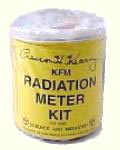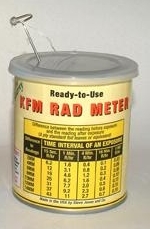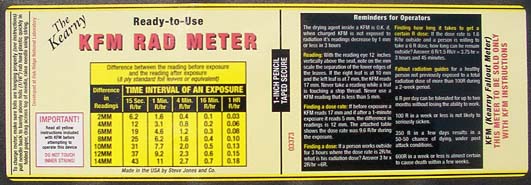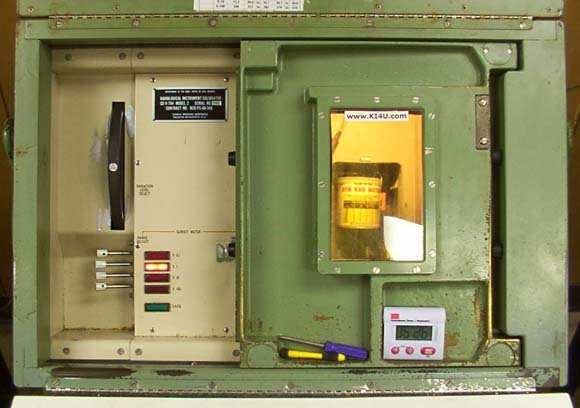"A survivor in a shelter that does not have a
dependable meter to measure fallout radiation
or that has one but lacks someone who knows
how to use it will face a prolonged nightmare of
uncertainties. Human beings cannot feel, smell,
taste, hear, or see fallout radiation."
"Which parts of the shelter give the best protection?
How large is the radiation dose being received by each person?
When is it safe to leave the shelter for a few minutes?
When can one leave for an hour's walk to get desperately
needed water? As the fallout continues to decay, how long
can one safely work each day outside the shelter? When can
the shelter be left for good? Only an accurate, dependable
fallout meter will enable survivors to answer these
life-or-death questions."
"With a reliable dose rate meter you can quite quickly determine
how great the radiation dangers are in different places, and then
promptly act to reduce your exposure to these unseen, unfelt dangers.
For example, if you go outside an excellent fallout shelter and learn
by reading your dose rate meter that you are being exposed to 30 R/hr,
you know that if you stay there for one hour you will receive
a dose of 30 R. But if you go back inside your excellent shelter
after 2 minutes, then while outside you will have received a dose
of only 1 R."
This KFM kit is based on the plans in the Nuclear War Survival Skills book,
Appendix C -
A Homemade Fallout Meter, the KFM - How to Make and Use It (The KFM kit
also comes with these same plans as a 12 page tabloid style newspaper.)
These plans were originally and specifically developed to be published in
every newspaper in this country on the eve of serious nuclear saber rattling
possibly leading up to WW III, so that every family in America would be able
to construct their own fallout meter right at home!
Either way, save the
time of a scavenger hunt to gather up the required materials and many of the tools. The
KFM kit also has MOST all of the critical construction steps completed for you and can be operational within an hour!
And, all the detailed (and essential) construction and operating instructions
are always there with the KFM kit where they'll be needed. Including how to
estimate the dangers from different radiation doses and how to use the KFM
to reduce them. OR, even quicker to use, get the NEW Ready-To-Use KFM here!
As Chapter 10 - Fallout Radiation
Meters also explains...
No radiation source is needed either to initially calibrate a KFM or
subsequently to check its accuracy. (Calibrations for accuracy were
completed at Oak Ridge National Laboratory and are the basis of the
KFM's attached table.)
A KFM is more accurate than most civil defense
instruments, and its accuracy is permanently established by the laws
of physics applicable to the specified dimensions and other
characteristics of its parts, and to their positioning relative to each
other- provided that it is made and maintained according to the
instructions. Unlike all factory-made radiation measuring civil defense
instruments that are reliable and available today, a KFM is charged
electrostatically. No battery is needed.
Endorsements for the above KFM kit...
"This kit will save many lives"
"This [KFM kit] is very good."
"Every American should have two of these kits."
"It isnt pretty and won't win awards for sophistication, but
under primitive conditions you'll also discover there is little to
go wrong"
"We believe you have something [the KFM kit] to offer that turely
could save many lives."
"It is always refreshing and exciting to find a product [the KFM
kit] that represents exceptional value."
"Makes a great Science experiment"
"[the KFM kit] is put together well."
"every Science teacher should have one of these kits"
This KFM kit has also been sold by the Boston Museum of Science.
Get your families Kearny Fallout Radiation Meter (KFM) Kit
here for only $55.00! First-Time Customers, You Can:
KFM classroom lessons, teacher guide and student handouts are here.
Also, complete technical data sheets here.
Jones and his daughter Amy examine one of the many kits in his kitchen. (Jeffrey D. Allred For The Washington Post)
By Don Oldenburg
When Steve Jones carried a curious duct-taped tin can with wires protruding from its clear plastic top into Sen. Rick Santorum's office last month, a wide-eyed Senate staffer remarked, "I'm surprised you got this stuff up here."
So was Jones. But for reasons other than heightened security on Capitol Hill. For more than a decade, the house painter from Salt Lake City has run up against public indifference as he promoted the jury-rigged can he insists would save lives in a dirty-bomb attack by terrorists.
One problem is the apparatus doesn't look like it could save lives. With two 1 1/2-inch-square aluminum leaves suspended on fishing line above small chunks of sheetrock inside the can, it's more likely to be mistaken for a hastily done science-fair project than what it is: a cheap homemade radiation detector designed by the federal government during the Cold War.
Called the Kearny Fallout Meter, or KFM, its purpose was to become the definitive radiation meter for Everyman. In a nuclear war, civilians could make it themselves at home and determine whether to stay inside.
"It's self-help civil defense," Jones says of the meter-in-a-can he demonstrated at four Senate offices in quest of referrals to the Department of Homeland Security. He wants Secretary Tom Ridge to inform Americans about the KFM through the department's emergency-preparedness Web site, Ready.gov.
"Ridge came up with that duct tape and plastic sheet thing," says Jones. "Now we're hoping he can do that for the KFM."
And history has shown that Jones is not a man who gives up easily.
A Child's Obsession
Jones has been wrestling with radioactivity ever since he was 12 and losing sleep over the Cuban missile crisis.
Growing up in Mountain Lakes, N.J., he was gripped by TV news reports of the 1962-63 crisis. He read the chilling atomic holocaust novels of the times, and like much of the U.S. population, he feared nuclear war was imminent. Unlike most people, he built himself a fallout shelter.
Enlisting the help of his 10-year-old buddy next door, Jones dug a gaping hole next to his father's garage, poured a concrete floor, erected five-foot-square cinder-block walls, and piled dirt over two-inch concrete panels for a roof. He tried to make a Geiger counter.
"He was always doing stuff like that," recalls Gordon Beh, the neighbor who helped him, now a Utah businessman. He recalls Jones planning to build a one-man helicopter and taping together newspapers to make a giant hot-air balloon.
Jones acknowledges that the Cuban missile crisis not only defined an era, it defined him. "We were on the verge of World War III!" says Jones, 52. "I resolved then and there that when I grew up I would build us one of the best darn bomb shelters I could build."
After graduating from high school, Jones enlisted in the Navy. In 1969, with the Vietnam War escalating, he learned to launch Polaris ballistic missiles in the nuclear submarine program. But he becamed troubled by the prospect of launching a nuclear warhead at people. In 1971, he took steps to become an in-service conscientious objector, and the Navy sent him quietly packing with an honorable discharge.
He wound up studying "peaceful alternatives" at Friends World College in Long Island, a Quaker school. After graduating, he moved his growing family to Salt Lake City in 1976, joined the Mormon church and worked at a food preparation company catering to Mormons. In a few years, he went into business for himself as a house painter.
But Jones never forgot the nuclear threat. In 1986, he found a Federal Emergency Management Agency blueprint for a fallout shelter designed to withstand a one-megaton warhead detonated a mile above ground.
Every weekend for two years, he shoveled the hole in his back yard, then buried an empty 30-foot-long diesel fuel tank and stocked it. His yard since then has been "a big mound" his 11 children use for sledding.
"All through high school, I was the kid who built the bomb shelter. People made fun of me for that," says Jones. "Then I came out here and built one, and I was the laughingstock of the neighborhood. But I don't have as much anxiety at night as other people do."
Cheap and Simple
Meanwhile, in the '70s, at the government's Oak Ridge National Laboratories, scientists were working on a $5 million nuclear survival project that included designing a radiation detector for the average American family.
Requirements called for a detector simple enough for a 12-year-old to make in a few hours from materials found around the house. It had to provide plus or minus 25 percent accuracy (comparable to many electronic radiation meters today, though high-end meters get plus or minus 15 percent accuracy). And it had to have a multiyear shelf life and require no batteries or materials that deteriorate.
"Several people had tried at different times to design and build home-makeable fallout meters but no one had succeeded," says Cresson H. Kearny, the Oak Ridge scientist who finally figured out how to build an electrostatically charged meter. His prototype evolved into the Kearny Fallout Meter, which can accurately measure dose rates from 30 millirads per hour up to 43 rads per hour.
Users charge the two aluminum leaves, suspended on the thread, with static electricity from a just-used comb. The leaves separate until radioactivity de-charges them -- the higher the dose, the closer they get. The change in separation is measured in millimeters marked across the clear plastic top, indicating relatively safe to dangerous levels of radiation.
Instructions for making the KFM were prepared at Oak Ridge to distribute to every U.S. newspaper, but the government apparently decided it was a political hot potato to suggest to Americans that they each needed a fallout meter. The KFM got little exposure.
"It did get out to the small percentage of the population interested in civil defense, but the general public was not concerned," says Kearny, 89.
The survivalist community -- which adopted Kearny's 1979 book, "Nuclear War Survival Skills," as its bible -- knew of the KFM. And a Salt Lake City house painter heard of it at a civil defense lecture.
"I hunted it down and built one," says Jones. "It was like a life goal! I finally finished my radiation meter!"
The Kearney Kit
In the early '90s, Jones set out on a mission to save the KFM.
His idea: While anyone could make a KFM from scratch using directions in Kearny's book, or from the Oak Ridge National Laboratory's Web site (www.ornl.gov) or the Oregon Institute of Science and Medicine Web site (www.oism.org), not everyone wants to. So he would make partially assembled kits to sell.
"I bought 40 cans of beans 'cause you make them out of the cans," he says. "My wife thought I was nuts."
He hauled the first 40 kits to a meeting of his volunteer civil defense group and sold out at $3.50 each. He made 40 more, and participants at a survivalist conference lined up for them. He made more.
But the general public proved wary. When Jones set up a big booth at the Utah State Fair, "thousands of people went by and laughed at me," he says. "I sold six in 10 days."
He became a familiar figure at relevant professional trade shows such as National Health Physics Society conferences. Because he couldn't afford a exhibition booth, he set up a street-corner table outside an American College of Nuclear Medicine convention in Philadelphia and drew such a crowd its organizers invited him inside.
In 1993, he got a break: Doctors for Disaster Preparedness mentioned KFM kits in its national newsletter and Jones was inundated with orders. His children had to pitch in to keep up with demand. He paid them $100 a month.
Then, in 1994, the American Nuclear Society contacted him about introducing KFMs in America's schools for radiation curriculum.
From there, Jones stumbled into other radioactive quests.
In 1995, he read newspaper accounts of a Denver shipping company that had a truckload of old, broken smoke detectors parked in its lot since 1983. The factory they were to be shipped to went bankrupt and the smoke detectors, which contain a mildly radioactive isotope, had become a controversy after 12 years.
The Colorado Health Department said disposal would cost $40,000. The Department of Energy and the Nuclear Regulatory Commission wanted nothing to do with the matter. Jones purchased the truckload for a dollar. Overcoming hassles with state and federal officials, he salvaged 18,000 of the smoke detectors to distribute to science teachers nationwide for radiation lessons.
A year later, Jones got wind that FEMA, dismantling the nation's defunct civil defense program, was going to dump more than a million dollars' worth of surplus Geiger counters into landfills. He got on the phone and, with the clout of Sens. Orrin Hatch and Rick Santorum, stopped the dumping. Twenty thousand of those Geiger counters have been distributed free to science teachers.
And since 9/11, others have been recalibrated and sold to emergency response organizations.
Student Gifts
Paul Lombardi's classroom got a smoke alarm and a Geiger counter, thanks to Jones. His students, studying radioactivity, recently made 120 KFMs. "This was a perfect thing to get the kids' attention," says the science teacher at South Davis Junior High in Bountiful, Utah.
Lombardi -- named 2002 national teacher of the year by the Health Physics Society -- says his students have made 600 KFMs and he has yet to find a student who couldn't. "These things are simple and they work," he says.
But Kim Kearfott, a nuclear engineering professor at the University of Michigan, says it took an undergraduate hours to assemble. And she says: "I think it's dangerous to tell people to use this as their sole way of monitoring radioactivity."
No problem for Gary Sandquist, a nuclear engineering professor at the University of Utah: "It is not a precise instrument, but if you got caught in a dirty-bomb environment, it's more than accurate enough."
Kathy Gant, a physicist working in emergency preparedness at Oak Ridge National Laboratories, witnessed the KFM's development in the '70s. "I don't think anyone here has tried one in years," she says. "But it was designed for the levels you would get after a radiation attack, and I think it would work as it was designed."
Family Project
"My family has made about 12,000 of them," says Jones. His older kids say they can't remember not making meters.
Matthew Jones, 26, the oldest of Jones's 11 children and a University of Utah physics major, has been making them since he was 10. "I'm quitting the meter business," he says. "I'm going to do something else."
Jones says sales have doubled every two years, yet he hasn't made money.
"The bottom line is . . . anyone who is motivated can make one from scratch for free."
Jones's wife, Cindy, 51, says she would welcome a profit but "he sees it as a cause."
Jones hatched a new idea this year: ready-made KFMs. Last July, he cut a deal with his neighbor to start that business.
"I couldn't see a 50-year-old housewife trying to make this," says Jones's neighbor, Eslie Barlow, 60, a businessman running the garage-based business.
To date, he has made 7,000, employing some of Jones's children and other neighborhood kids.
Commercial emergency-preparedness Web sites such as KI4U.com sell the kit for $55 and the ready-to-use KFM for $75, and link to free plans for do-it-yourselfers.
In the past year, about 3,000 kits and 1,500 ready-mades were shipped to retailers.
"If this thing ever goes mainstream," says Barlow, "we'd set up a factory. The key is people don't know this thing is available."
A New Urgency
In today's troubled world, Jones feels greater urgency than ever to spread the word.
"It's like déjà vu. This feels a little bit like the Cuban missile crisis to me," he says in a cheap D.C. hotel room after demonstrating the KFM on Capitol Hill.
But initial reaction in the Senate offices was noncommittal, he says.
Longtime friend Bob Kilbanks, an Easton, Pa., real estate executive who accompanied Jones, feels more positive. They said they found it "relevant to the times," he says. "I think it went well."
Later that day, Santorum sent a letter to Ridge recommending he meet with Jones.
And Jones submitted a formal request to the Department of Homeland Security that it direct the public to the free KFM material on the Oak Ridge Web site.
"The ball's in their court," says Jones.
"This has been paid for by tax dollars. Let's use it!"
© 2003 The Washington Post Company
Get your families Kearny Fallout Radiation Meter (KFM) Kit
here for only $55.00! First-Time Customers, You Can:
Last Updated: January 5th, 2007
Kearny Fallout Radiation Meter (KFM) Kit & Free Plans
From Oakridge National Labs Nuclear War Survival Skills,
Chapter 10
Fallout Radiation Meters...
The Kearny Fallout Meter (KFM) has everything needed to make and use a radiation measuring
device.
Accurately measures dose rates from 30 mR/hr (0.03 R/hr) up to 43 R/hr.
The KFM has undergone rigorous scientific testing in several laboratories
where its accuracy and dependability were confirmed.
Including Oak Ridge National Laboratory where it was developed by
Cresson H. Kearny, author of Nuclear War Survival Skills. Designed to be assembled by a junior high age student,
thousands of KFM's have been built worldwide. This same KFM kit has
been endorsed by and listed as the sole source in the latest NWSS edition.
It also comes with very detailed construction, operating and testing instructions.
Also includes a free (non-working) smoke detector to use as a safe radioactive testing source along with color indicating
silica gel.
And, it does not require a battery. Great science project, too! (Science teachers, be sure to see/read 'The KFM Story' below!)

You can use these free plans and parts list to construct your own
KFM from scratch, or
acquire the KFM kit for $55
OR the NEW Ready-To-Use KFM for only $75.00!


Label from the NEW Ready-To-Use KFM version just released.
A KFM combines the provenly practical radiation measuring functions of an
electroscope and of an ionization chamber having a specified volume.
Oh, and yes, it will do radon gas, too! Instructions included. But, it is not specifically
certified by the EPA for this application.

KI4U, Inc.,
a licensed radiological laboratory, testing the KFM in our Cesium Calibrator.
-Cresson Kearny
-Dr. Edward Teller
-Art Robinson, Oregon Institue of Science and Medicine
-American Survival Guide, pg 12, 4/94
-letter from Doctor for Disaster Preparedness, 10-13-96
-Preparedness Journal, May/June, 1995, pg 22
-American College of Nuclear Physicians, in a flyer to
its members telling them how to order KFM kits, 5-5-95
Marily DeWall, Associate Executive Director National Science
Teacher Association , in an interoffice memo
-Professor Gary Sandquist, head of Nuclear Engineering
School at University of Utah
OR, the NEW Ready-To-Use KFM for only $75.00 here!
Includes same-day shipping via USPS Priority Mail!
Check Out KI4U, Inc. Background, Expertise &
Customer Comments Here!
CRESSON H. KEARNY
Civil Defense Consultant, Retired

A Man, A Plan, A Tin Can
Homemade Fallout Meter Could Be the New Duct Tape
Washington Post Staff Writer
Sunday, April 13, 2003; Page F01
OR, the NEW Ready-To-Use KFM for only $75.00!
Includes same-day shipping via USPS Priority Mail!
Check Out KI4U, Inc. Background, Expertise &
Customer Comments Here!
about.com says about...
Potassium Iodide Anti-Radiation Pill FAQ
"In-depth, detailed site totally dedicated to the Potassium Iodide issue.
THE central resource on the topic."

|
|
© www.NukAlert.com 2003, 2004, 2005, 2006, 2007. All Rights Reserved.
© www.RadShelters4U.com 2002, 2003, 2004, 2005, 2006, 2007. All Rights Reserved.
© www.RadMeters4U.com 2001, 2002, 2003, 2004, 2005, 2006, 2007. All Rights Reserved.
© www.KI4U.com 1999, 2000, 2001, 2002, 2003, 2004, 2005, 2006, 2007. All Rights Reserved.